Marketing has evolved in ways that no one could have predicted over the last ten years. Broad, generic campaigns are no longer effective with consumers. They anticipate that brands are aware of their identities, preferences, and even potential future needs. Nowadays, a lot of people are dissatisfied when they receive content that does not suit their tastes. Hyper-personalization is a result of this expectation.
Hyper-personalization is more than just a trendy term in marketing. By 2025, it will be the norm for how companies interact with their clientele. Hyper-personalization is reshaping the digital experience in previously unthinkable ways, whether it is through streaming platforms that recommend the ideal show, eCommerce stores that suggest products that seem hand-picked, or business-to-business websites that modify their messaging according to the visitor's company profile.
AI content customization tools are at the heart of this change. These platforms create customized experiences at scale by utilizing machine learning, artificial intelligence, and predictive analytics. What hyper-personalization is, how AI enables it, why it matters, and which tools are at the forefront right now will all be covered in this article.
Table of Contents
What is Hyper-Personalization?
Personalization has been around for years, but it used to mean little more than inserting a customer’s first name into an email subject line. Hyper-personalization takes this concept much further. It is the process of delivering tailored content and experiences by analyzing real-time data such as browsing behavior, purchase history, location, time of day, and even micro-signals like cursor movement or dwell time on a page.
For example, a customer visiting an online fashion retailer might immediately see a homepage featuring styles that match their past purchases, sizes that fit their profile, and seasonal offers relevant to their region. Another example is in financial services, where banks now use hyper-personalization to offer customers recommendations on saving plans or credit options based on spending habits.
This level of depth is what sets hyper-personalization apart. It is not just about who the customer is, but also about what they are doing right now and what they are most likely to need next.
How AI Powers Hyper-Personalization
Without AI content customization, hyper-personalization would not be possible on this scale. AI can track thousands of customers in real time, something that marketers cannot do by hand. Machine learning-powered algorithms continuously analyze consumer data and spot trends that people would overlook.
Chatbots and virtual assistants can respond in a conversational rather than robotic manner thanks to natural language processing. Systems can anticipate customer needs before they are expressed thanks to predictive analytics. Consider a grocery app that suggests recipes based on the items you recently added to your cart, or an airline that offers a discount on baggage fees immediately after you book a low-cost flight.
Content automation is also powered by AI. Businesses can send out thousands of highly customized emails, each one tailored to a different customer segment, rather than just one or two. With real-time personalization, a website can change on the fly, displaying different calls to action, banners, or suggestions based on the visitor's profile and behavior.
When combined, these features enable the provision of experiences that resemble organic interactions rather than advertising campaigns.
Benefits of AI Content Customization Tools
The advantages of investing in hyper-personalization are clear, and they extend to both businesses and customers. Some of the most impactful benefits include:
- Higher engagement and conversion rates because customers are more likely to respond positively when content feels tailored specifically to their needs and interests.
- Greater efficiency in marketing spend, as campaigns reach the right audience at the right time, reducing waste and increasing return on investment.
- Improved customer loyalty and trust through consistent delivery of relevant and valuable interactions, which makes customers return for the experience, not just the product.
Top AI Content Customization Tools in 2025
Now that we understand why AI content customization matters, let’s look at the leading tools businesses can use to put it into action. Each platform offers unique strengths, and the right choice depends on your industry, goals, and resources.
1. Optimizely: Experimentation Meets Personalization
From a basic A/B testing tool, Optimizely has developed into one of the most extensive platforms for customization and experimentation. Its strength is in enabling businesses to continuously optimize experiences by fusing AI-driven customization with scientific testing.
Optimizely changes in real time, unlike static campaigns. A media website might, for instance, experiment with various article headlines and display tailored content to various audience segments. It is particularly useful for businesses that don't want to choose between personalization and experimentation because they can have both thanks to this dual capability.
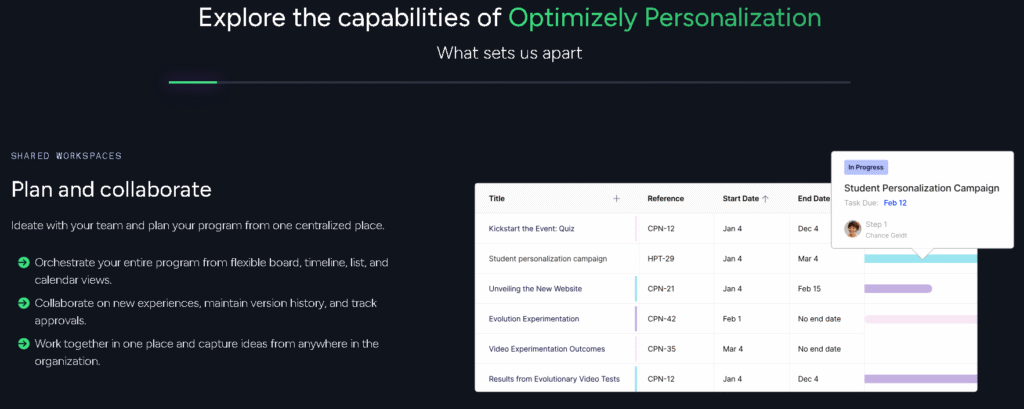
Key strengths of Optimizely:
- Advanced A/B and multivariate testing combined with AI personalization.
- Deep integration with commerce and CMS platforms.
- Real-time decisioning so experiences update instantly based on user behavior.
Limitations to consider:
While Optimizely offers enormous flexibility, it comes at a high price and requires a certain level of technical expertise. Smaller businesses may find the investment hard to justify.
Pricing: Starts around $50,000 per year.
Best for: Enterprises that value testing and personalization equally and need a unified platform.
2. Adobe Target: Personalization for the Enterprise
As a component of the Adobe Experience Cloud, Adobe Target is one of the most well-known enterprise personalization tools. It makes use of Adobe Sensei, a framework for AI and machine learning, to automate testing and customization choices on a large scale.
When used as a component of Adobe's ecosystem, the tool excels. For instance, a fashion retailer can use Adobe Analytics to learn about customer browsing patterns and then use Adobe Target to tailor recommendations for email, mobile, and the web.
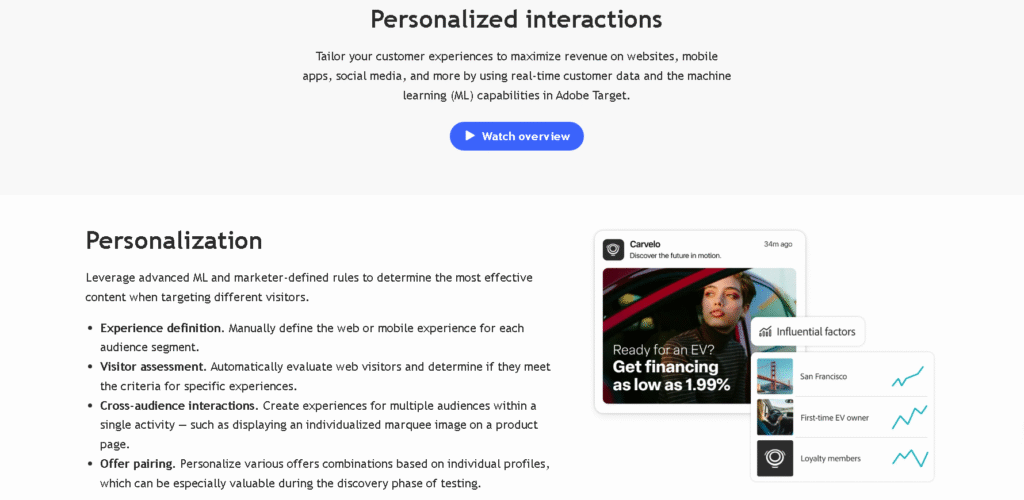
What makes Adobe Target powerful:
- Supports multivariate and automated testing.
- AI-driven decisioning via Adobe Sensei.
- Cross-channel personalization for websites, apps, and emails.
- Seamless integration with Adobe Analytics and Adobe Experience Manager.
Drawbacks:
- Steep learning curve teams often need dedicated training.
- Expensive, making it suitable only for large organizations.
Pricing: Starts around $100,000 per year.
Best for: Global enterprises that already use Adobe’s ecosystem and want advanced personalization capabilities across multiple channels.
3. Dynamic Yield: Scalable Personalization for Retail
Dynamic Yield, which is now a part of Mastercard, focuses on retail personalization and eCommerce. Delivering consistent experiences through both digital and physical channels is its main goal. Using the same technology, a consumer looking at sneakers online may subsequently receive tailored in-store promotions.
One notable feature of the platform is its user-friendly interface, which enables marketers to start campaigns without continual developer assistance. In hectic retail settings, this speed is a huge advantage.
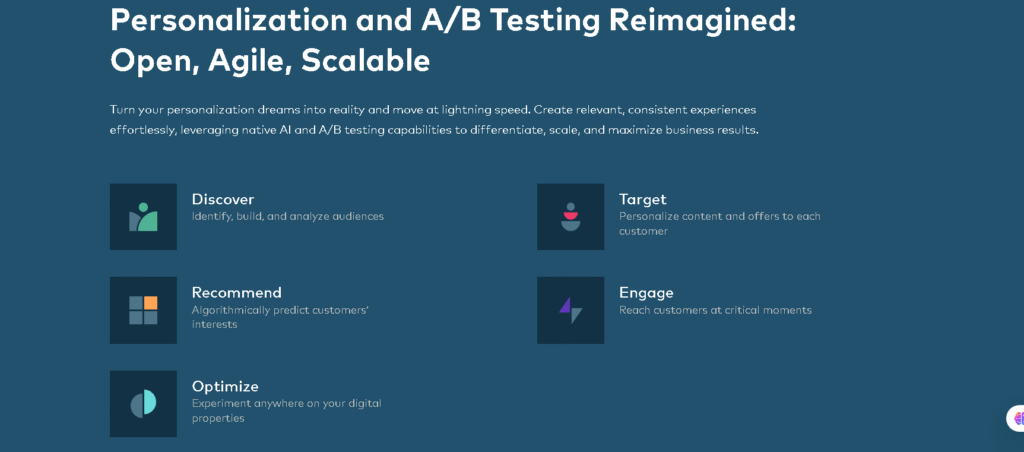
Top features include:
- AI-driven product recommendations.
- Personalized promotions across web, mobile, and even point-of-sale.
- Audience segmentation and behavioral targeting.
- Omnichannel consistency that ensures a unified customer journey.
Challenges:
While it excels in personalization, its reporting and analytics features are less robust compared to competitors like Adobe Target.
Pricing: Starts around $50,000 annually.
Best for: Large retail and eCommerce companies seeking consistent, cross-channel personalization.
4. Segment by Twilio: Data as the Foundation
Segment is a customer data platform (CDP), not just a personalization tool like the majority of the platforms on this list. Its function is to consolidate consumer information from various touchpoints, enabling hyper-personalization.
Consider it the cornerstone of customization. Even the most sophisticated AI personalization tools fall short in the absence of clean and consistent data. Segmentation guarantees that customer interactions from email, CRM, mobile, and the web are combined into a single profile.
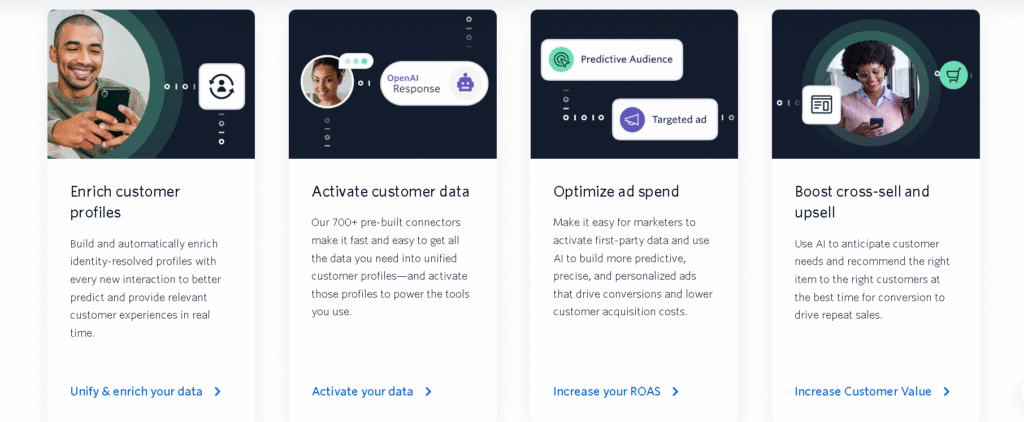
Why Segment matters:
- Centralizes and cleans customer data.
- Connects to hundreds of downstream tools (including Optimizely, Mutiny, and VWO).
- Enables real-time personalization by ensuring unified profiles.
- Offers a free tier for startups and small businesses.
Limitations:
It doesn’t provide out-of-the-box personalization features. Instead, it acts as the data infrastructure that powers other personalization platforms.
Pricing: Free for small projects, with paid plans starting at about $120 per month.
Best for: Businesses that want strong data hygiene and reliable personalization pipelines.
5. Mutiny: Personalization for B2B Companies
Mutiny was created especially for account-based marketing (ABM) and B2B personalization. It assists SaaS and enterprise businesses in providing customized website experiences catered to various business segments, in contrast to retail-focused tools.
To make sure the messaging is effective for each audience, a SaaS provider might, for instance, show Fortune 500 companies and small startups different landing page content. Mutiny even offers AI-powered suggestions for the adjustments that will have the most effect.
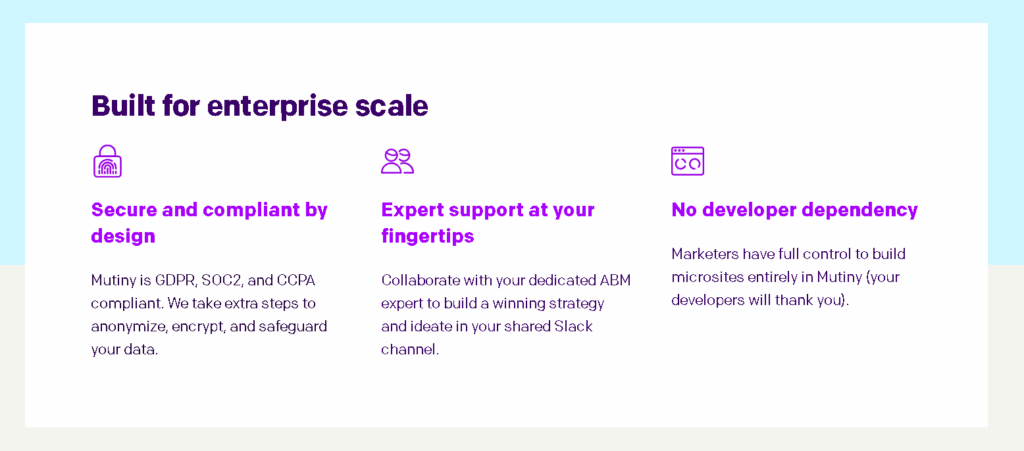
Where Mutiny excels:
- Account-based website personalization.
- No-code editor, making it easy for marketers to implement changes.
- AI insights that suggest the best personalization opportunities.
- Focused on SaaS and B2B, where customer journeys are complex.
Limitations:
- Narrower focus it’s not designed for retail or consumer personalization.
- Pricey for smaller B2B companies.
Pricing: Starts around $3,000 per month.
Best for: SaaS and B2B companies that want to personalize account-based experiences without relying on developers.
6. Bloomreach: Personalization Engine for eCommerce
Bloomreach is a single platform that integrates AI-powered recommendations, content personalization, and site search. It works especially well for companies that have extensive product catalogs, as this can easily overwhelm customers.
Consider a consumer looking for "running shoes." In addition to providing accurate search results, Bloomreach uses browsing and purchase history to dynamically recommend related products like running watches or athletic socks.

Notable features:
- AI-powered site search and navigation.
- Dynamic product recommendations.
- Personalized content modules across web and mobile.
- Strong focus on large-scale eCommerce.
Challenges:
Its advanced capabilities come at a steep price and are generally aimed at enterprise eCommerce businesses rather than SMBs.
Pricing: Typically starts at $50,000+ per year.
Best for: Large online retailers managing complex catalogs and customer journeys.
7. VWO Personalize: Accessible for SMBs
VWO Personalize brings AI-powered personalization to small and medium businesses. It combines affordability with intuitive tools for A/B testing, targeting, and real-time personalization.
A mid-sized retailer could use VWO to deliver different homepage banners to first-time visitors versus repeat customers, or to personalize calls-to-action based on geographic location. It doesn’t match the depth of Adobe or Optimizely, but it delivers excellent value for its price.

Strengths include:
- Affordable entry point into personalization.
- Easy-to-use interface for marketers.
- Real-time targeting based on visitor behavior.
- Includes A/B and multivariate testing.
Drawbacks:
- Limited advanced features compared to enterprise platforms.
- Best suited for SMBs rather than global enterprises.
Pricing: Starts at $199 per month.
Best for: SMBs and growing businesses that want affordable personalization without enterprise-level complexity.
Comparison Table: Best AI Content Customization Tools 2025
| Tool | Key Features | Pricing | Best Use Case |
|---|---|---|---|
| Optimizely | AI testing & personalization | From $50,000/year | Enterprises needing experimentation + AI |
| Adobe Target | AI-driven testing & automation | From $100,000/year | Large organizations with complex data needs |
| Dynamic Yield | Real-time eCommerce personalization | From $50,000/year | Retailers and eCommerce brands |
| Segment | Customer data unification | From $120/month | Data-driven personalization foundation |
| Mutiny | B2B-focused website personalization | From $3,000/month | SaaS and B2B organizations |
| Bloomreach | Search + content automation AI | From $50,000+/year | Large eCommerce catalogs |
| VWO Personalize | Affordable personalization platform | From $199/month | SMBs and growing businesses |
Challenges and Ethical Concerns
While hyper-personalization offers remarkable opportunities, it also comes with important challenges. Key issues include:
- Privacy and transparency, since customers are increasingly aware of how their data is collected and may reject brands that fail to communicate openly.
- Data security risks, because personalization relies on large amounts of customer data that must be protected against breaches.
- Over-targeting concerns, as excessive personalization can feel invasive rather than helpful, leaving customers uncomfortable instead of valued.
The key is balance. Businesses must aim to delight customers with relevant experiences while respecting their privacy and maintaining transparency.
The Future of AI Content Customization Tools
AI tools for customizing content will keep developing in the future. The incorporation of personalization into voice and conversational AI is a significant trend that enables users to receive customized recommendations via chat interfaces and voice assistants. Additionally, predictive personalization will advance, with systems predicting client needs before they are articulated.
Cross-channel consistency is another new trend. Consumers expect personalization to follow them seamlessly across all of these touchpoints as they navigate between websites, apps, emails, and offline experiences. In the upcoming years, companies that can provide this degree of integration will be distinguished.
FAQs on AI Content Customization
1. What is AI content customization?
AI content customization is the use of artificial intelligence to deliver personalized experiences. It analyzes customer data such as browsing behavior, preferences, and purchase history to create tailored recommendations and messages in real time.
2. How does AI content customization improve customer experience?
By tailoring content to individual users, AI content customization ensures that customers see content that feels relevant to them. This creates deeper engagement, increases satisfaction, and builds stronger loyalty.
3. What are the best AI content customization tools in 2025?
Leading platforms include Adobe Target, Optimizely, Dynamic Yield, Segment, Mutiny, Bloomreach, and VWO Personalize, each offering unique strengths for different industries.
4. Is AI content customization only for large businesses?
No. While enterprise-grade platforms serve global organizations, affordable tools like VWO Personalize and Segment make hyper-personalization accessible to small and medium-sized businesses as well.
5. How much do AI personalization tools cost?
Pricing ranges from $199 per month for entry-level tools like VWO Personalize to over $100,000 annually for enterprise solutions like Adobe Target.
6. What is the future of AI content customization?
The future lies in predictive analytics, conversational AI, and seamless cross-channel personalization that follows customers across every interaction point.
Conclusion
The future of customer engagement is hyper-personalization; it is no longer an option. Companies are setting themselves up for success in the cutthroat market of the future by investing in AI content customization platforms now. There is a tool for every size and kind of business, ranging from accessible platforms like VWO Personalize to enterprise solutions like Adobe Target and Optimizely.
Just starting is the most crucial step. Begin modestly, try different things, and gradually expand your personalization efforts. Businesses that transcend generic advertising and provide each customer with experiences that feel truly unique will be the ones that thrive in 2025 and beyond.
At tooljunction, we share honest AI tool reviews and tutorials to help you choose the right tools for your creative projects.
For more insights, explore our AI SDR Agents 2025: The Ultimate Rise in B2B Sales, read our AI Prompting Courses: 10 Best for Non-Techies, or check our 5 Best AI Tools for Sales Team in 2025 to find the perfect solution for your needs.




